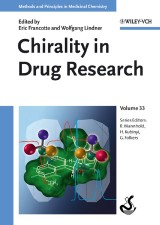Details

Chirality in Drug Research
Methods & Principles in Medicinal Chemistry, Band 33 1. Aufl.
|
205,99 € |
|
| Verlag: | Wiley-VCH |
| Format: | |
| Veröffentl.: | 24.09.2007 |
| ISBN/EAN: | 9783527608713 |
| Sprache: | englisch |
| Anzahl Seiten: | 370 |
DRM-geschütztes eBook, Sie benötigen z.B. Adobe Digital Editions und eine Adobe ID zum Lesen.
Beschreibungen
Divided into the three main sections of synthesis, analysis and drug development, this handbook covers all stages of the drug development process, including large-scale synthesis and purification of chirally pure pharmaceuticals. <br> The two editors from academia and a major pharmaceutical company have assembled an experienced, international team who provide first-hand practical advice and report previously unpublished data.<br> In the first section, the isolation of chiral drugs from natural sources, their production in enzymatic processes and the resolution of racemic mixtures in preparative chromatography are outlined in separate chapters. For the section on qualitative and quantitative analysis, enantioselective chromatographic methods are presented as well as optical methods and CE-MS, while the final section deals with the pharmacology, pharmacokinetics and metabolic aspects of chiral drugs, devoting whole chapters to stereoselective drug binding and modeling chiral drug-receptor interactions. <br> With its unique industry-relevant aspects, this is a must for medicinal and pharmaceutical chemists.<br>
INTRODUCTION<br> Chiral drugs from a historical point of view (J. Gal)<br> <br> SYNTHESIS<br> Stereoselective synthesis of chiral drugs (H. Federsel)<br> Chiral drugs from natural source (F. Petersen)<br> Biotransformation methods for preparing chiral drugs and drug intermediates (M. Muller, M. Wubbolts)<br> <br> SEPARATIONS<br> Resolution of chiral drugs and drug intermediates by crystallisation (K. Saigo)<br> Resolution of chiral drugs by preparative chromatography (E. Francotte)<br> <br> ANALYSIS<br> Stereoselective chromatographic methods for drug analysis (W. Lindner)<br> CE-MS for the quantitative analysis of chiral drugs (J. Veuthey)<br> Spectrosopic methods for chiral drug analysis (N. Harada)<br> Modeling of chiral drug-receptor interactions (G. Folkers)<br>
"... In general, the book has been welledited and produced and contains a useful subject index."<br> ChemMedChem<br> <br> "...As appropriately stressed throughout the book, the several issues associated with chirality have emerged as major factors in drug design and development. This book is a timely and well written resource."<br> Journal of Medicinal Chemistry, 06/2007<br> <br> "...Overall this is a useful book for process chemists working with chiral compounds in industry and the chapters highlighted in this review are recommended reading."<br> Organic Process Research and Development Journal, 08/2007
Eric Francotte received his BS and PhD degrees from the University of Louvain (Belgium). After postdoctoral work at the University of Geneva, he joined the Central Research Laboratories at Ciba-Geigy, where he was working on optically active polymers. He is now Director and Head of Separations at the Novartis Institutes for BioMedical Research in Basel (Switzerland). He is also an editor of the Wiley journal "Chirality". His major interests include development and applications of chiral stationary phases for the separation of stereoisomers on an analytical and preparative scale. <br> <br> Wolfgang Lindner received his PhD degree in Organic Chemistry from the University of Graz (Austria). After several academic positions, including a period at the FDA in Bethesda (USA), he was appointed the chair in Analytical Chemistry at the University of Vienna (Austria). He is also the editor of the Journal of Chromatography B, and the current president of the Austrian Society of Analytical Chemistry. His major interests lie in enantioselective separation techniques, including LC, CE, membranes, extractions, and in stereoselective pharmacokinetics.
Most pharmaceutically active compounds possess a chirality that greatly influences their pharmacological properties. Since all pharmaceutical products nowadays are produced in chirally pure form, this places huge demands on the technology used for drug synthesis, purification, analysis and testing.<br> Here, the two editors from academia and a major pharmaceutical company have assembled an experienced, international team to provide first-hand practical advice and report previously unpublished data.<br> Divided into the three main sections of synthesis, analysis and drug development, this handbook covers all stages of the drug development process, including large-scale synthesis and purification of chirally pure pharmaceuticals. <br> In the first section, the isolation of chiral drugs from natural sources, their production in enzymatic processes and the resolution of racemic mixtures in preparative chromatography are outlined in separate chapters. For the section on qualitative and quantitative analysis, enantioselective chromatographic methods are presented as well as optical methods and CE-MS, while the final section deals with the pharmacology, pharmacokinetics and metabolic aspects of chiral drugs, devoting whole chapters to stereoselective drug binding and modeling chiral drug-receptor interactions. <br> With its unique industry-relevant aspects, this is a must for medicinal and pharmaceutical chemists.


















